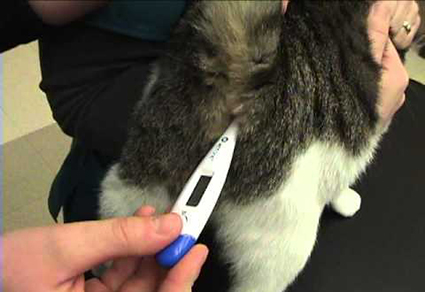Taking Your Pet’s Temperature

Taking Your Pet’s Temperature
Since the medical thermometer was invented in 1866, every physical examination includes a body temperature measurement. The assessment of this parameter helps veterinarians direct the diagnostic plan. For example, in a cat with an elevated body temperature, we think about diagnoses like a cat bite abscess, a postoperative infection, or an infectious disease like feline infectious peritonitis. In a dog with a decreased body temperature, we worry about poor blood flow and an inability to maintain temperature as a result of heart failure or kidney disease.
Normal Temperature
Everyone knows the normal human body temperature is 98.6F. Based on my experience, I would guess very few know the normal canine temperature is between 100.2 and 103.8 and the normal feline temperature is between 100.5 and 102.5F. I say that because I frequently receive frantic emails and phone calls about a “fever” in a sick pet that turns out not to be a fever. Body temperature can be measured using thermometers placed in a variety of body parts, like the mouth, ear, armpit, and rectum. Obviously, in pets, an oral temperature is out of the question, but the other methods have all been studied in pets.
Rectal Temperature
The gold standard for measuring temperature is the rectal temperature. The temperature of the rectal lining (mucosa) correlates well with the core body temperature and is the most common method used to measure body temperature at the Animal Medical Center. To prevent transmission of disease by the thermometer, we cover it with a disposable, lubricated sheath. I also use additional water soluble lubricant in an attempt to make the process less stressful for the patient. But because the methodology of rectal temperature is stressful, other methods have been investigated.
Ear Thermometry
In children, a common method of assessing body temperature measures the infrared radiation emanating from the tympanic membrane using a special thermometer. Every parent knows how easy this is, even in a sleeping child. The problem in pets is the thermometers need to be carefully positioned, and even then ear thermometers do not always give results that match rectal temperatures. So, based on this information, you should not use your child’s ear thermometer to measure your pet’s body temperature.
Armpit Temperature
Another location promoted for low stress temperature taking is the axilla or armpit. This location would seem to be a much easier place to coerce a wiggly pet into being still for a few minutes while you slip a thermometer into their armpit. But, this method does not give repeatable results which are dependable when it comes to caring for your favorite fur baby.
If you need to take your pet’s temperature, the tried and true rectal method is still the best. Keep an extra digital thermometer and some lubricant available in case you need to check.

































